| IX 529 Sea Shadow
美国IX 529“海影”试验船 Date:2016-01-25 Source:GlobalSecurity By:Globalmil Viewed: |
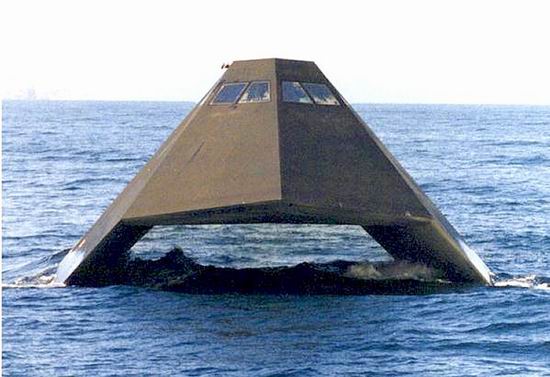
美国IX 529“海影”试验船
Sea Shadow is a test craft developed under a combined program by the Advanced Research Projects Agency (ARPA), the Navy, and Lockheed Martin Missiles and Space Company. The Sea Shadow program was begun in the mid-1980s. Its purpose is to explore a variety of new technologies for surface ships, including ship control, structures, automation for reduced manning, seakeeping and signature control. The Sea Shadow was built in the mid-1980s by Lockheed in the Hughes Mining Barge (HMB-1) in Redwood City, CA. The vehicle is 160-ft. long, 70-ft. wide, displaces 560 tons and has a draft of 14 ft. It has a maximum speed of approximately 13 knots and is powered by a twin screw diesel electronic drive. The ship has a maximum speed of 14 knots and is capable of operating in Sea State 5 (extremely rough) conditions. The vehicle cost approximately $50 million to build and the total test program is approximately $195 million over roughly 10 years. It is owned by the Navy and operated by LMSC personnel.
海影试验船是在一个组合的计划之内通过(美国国防部)高级研究计划署 (ARPA),美国海军和洛克希德·马丁导弹和空间公司(LMSC)来发展。海影计划在1980年中期开始进行。它的目的是探究一个多样性新技术用于水面舰船,包括航运控制,结构,自动操作用于简化人员配备,经得起海上风浪和信号控制。海影在1980年中期被洛克希德公司在休斯采矿驳船(HMB-1)中建造,地点在美国加州的Redwood City。运载体长度160-英尺,宽度70-英尺,排水量560吨而且有一个14英尺深的吃水线。它有一个大约14节最高速度并且使用一对螺旋浆柴电驱动器。并且有能够在海况5级(非常恶劣)条件中操作。运载体大约花费五千万美元建造,而且在大概10年时间里总测试程序大约是一亿九千五百万美元。它是美国海军特有的而且被LMSC人员操作。
The Sea Shadow is a limited mobility platform used for testing and research of shipboard advanced technologies, and is not a prototype for follow on construction. The Sea Shadow incorporates a Small Water Plane Area Twin Hull (SWATH) hull form with canted struts extending below the water line to torpedo-shaped hulls. The design allows for exceptional sea keeping performance. Fins mounted on the front and back of the inboard sides of the lower hulls provide the control surfaces for turning the vehicle, eliminating the need for conventional rudders and reducing drag. The ship's sloped sides are an extension of the angled struts, whose design are driven by signature, hydrodynamic and structural considerations. Several technologies from the Sea Shadow have been incorporated into Navy ships including signature control on Arleigh Burke-class destroyers. Also, Sea Shadow's Small Waterplane Area Twin Hull (SWATH) technology has been incorporated into the TAGOS-19, a twin hull ocean surveillance ship.
海影是一艘有限机动性平台使用,用于测试和研究舷侧先进技术,并且只有一个原型没有继续建造下去。海影混合的一个小水面面积双船体(SWATH)船体线型使用斜面支撑向下延伸在吃水线扩充成鱼雷形状(torpedo-shaped)。设计考虑到例外的海况保持性能。船体下面舷内侧前面和后面被安装鳍状物供给控制界面用于运载体转向,除去对传统的舵需要并且减轻阻力。船的倾斜侧面是一个成角支撑的延长,这些设计受到驱策被信号(船体可探测信号特征),水动力学和结构的考虑。来自海影的一些技术已经被整合到海军舰艇,包括信号控制用在宙斯盾级驱逐舰上。同样,海影小的水线面面积双船体 (SWATH) 技术已经与TAGOS-19合成一体,一艘双船体海洋监视船。
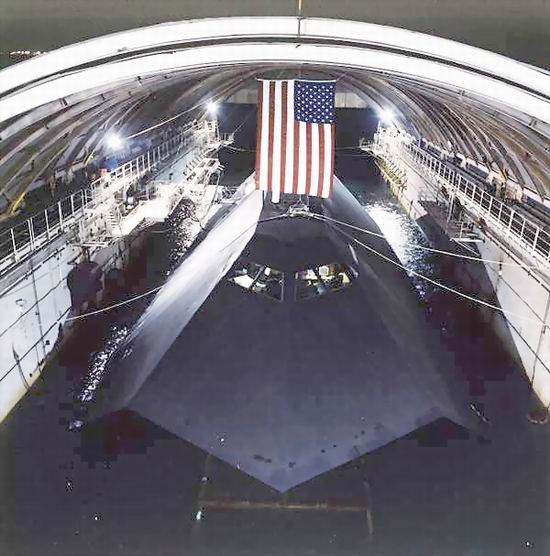
海影在休斯采矿驳船(HMB-1)中秘密建造维护
On 11 April 1993 Lockheed Missiles & Space Co. and the U.S. Navy today began daylight testing of Sea Shadow off the coast of Southern California, the first time the craft was revealed to the public. Prior to that, all ship testing had been conducted at night, with the Sea Shadow returning to the Hughes Mining Barge prior to daylight. Preliminary testing followed construction, but the vehicle had been in storage since 1986. The Hughes Mining Barge (HMB-1) serves as a docking platform for the Sea Shadow and provides spares, fuel and shore power to support the vehicle during testing. In March 1994 the US Navy and Lockheed Missile and Space Co. (LMSC) started testing the Sea Shadow in battlegroup operations off the coast of Southern California. The tests were designed to explore the application of various advanced technologies to surface ships including ship control, structures, automation, sea keeping and signature control as well as operating in joint exercises with other Navy ships.
在1993年4月11日洛克希德导弹&空间公司(LMSC)和美国海军开始了海影的白天测试在南加州的海面上,这也是试验船第一次对民众展示。在那之前,所有与试验船测试有关的行为都在晚上,海影白天返回到休斯采矿驳船(HMB-1)中。初步测试后继续建造,但是运载体自从1986建造开始一直处于秘密储藏状态。休斯采矿驳船(HMB-1)适合当做一个进坞平台用于海影并且提供机械备用件,燃料和岸电支持测试期间运载体。在1994 年3月美国海军和洛克希德导弹和空间公司 (LMSC)启动海影测试在战斗群中操作在南加州的海面上。测试被有计划探究各种各样的先进技术应用到水面舰艇航运控制,结构,自动操作,海洋监护和信号抑制也在和其他的海军舰船的联合练习中操作。

“海影”试验船侧面照片
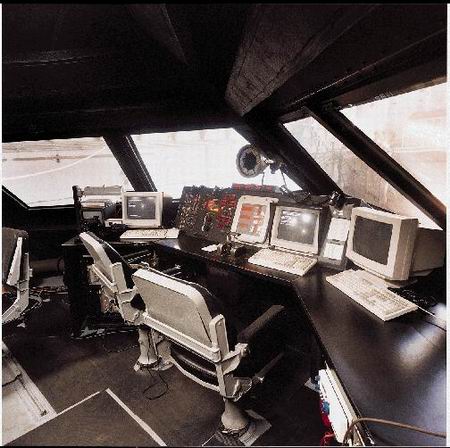
海影驾驶室
In the Fall of 1994 it served for the first time as a test platform for advanced Combat Systems prototypes. These prototypes were adapted to the Sea Shadow's test profile. The prototypes were designed to be driven by active radar, passive sensors, and Tactical Data Link 11 and 16. The test profile dictated operating in a receive-only mode for track information from Link 11, relying on off-board sensors only. The reference data, including maps and commercial airways, was loaded into the prototypes to cover testing along the Southern California coast. The two Combat System prototypes were the Automated Combat Identification System (ACIDS) and the Tactical Action Advisor (TAA). ACIDS is designed as a decision aid to automatically identify air and surface tracks based on sensor and intelligence information as defined by the tactical operators. The TAA system is a decision aid that supports a Tactical Action Officer or Warfare Commander in determining threats to ownship based on ownship signatures, threat sensors and threat weapons. Systems such as ACIDS and TAA are of value to various platforms, but are particularly important when mission requirements dictate no operation of active sensors. The testing and demonstration of the ACIDS and TAA prototypes on the Sea Shadow was funded by ARPA as part of the High Performance Distributed Experiment (HiPer-D) program.
在1994 年秋天它第一次用于先进战斗系统原型服务当做一个测试平台。这些原型是适应海影的测试外廓线。原型是有计划的受到驱策被主动雷达,被动(无源)传感器,和战术诸元数据链 11号和16号。外形测试操作指令在一个单向-接收(receive-only)模态用于跟踪信息来自数据链11号,仅仅依靠分离-仪表板(off-board)传感器。参考数据,包括地图和一些商业航空航线,被载入原型沿着南加州海岸测试。二个战斗系统原型是由自动化的战斗识别系统(ACIDS)和战术行动顾问(TAA)构成。自动化的战斗识别系统(ACIDS)是有计划被战术操作员看做一个决策援助去自动识别空中和水面跟踪基于传感器和智能信息。战术行动顾问(TAA)系统是一个决策援助支持一个战术行动指挥或者作战指挥官从事于决定威胁到ownship基于ownship信号,威胁传感器和威胁武器。系统例如象像ACIDS和TAA是有价值的用于各种不同的平台,但是特别地重要的任务需求指令主动传感器不运转。在海影上ACIDS和TAA 原型的测试和示范被(美国国防部)高级研究计划署(ARPA)赞助被看做高性能分布式实验(HiPer-D)计划的一部分。
Following conclusion of testing, the Sea Shadow and Hughes Mining Barge were moved to San Diego and docked at the 32nd Street pier. By late 1994 Sea Shadow was maintained in a lay-up status and homeported at Naval Station San Diego.
在测试结束之后,海影和休斯采矿驳船(HMB-1)被转移到圣地亚哥并且在32nd Street码头。在1994 后期之前海影继续处在闲置状态和港口位置在海军的圣地亚哥站。
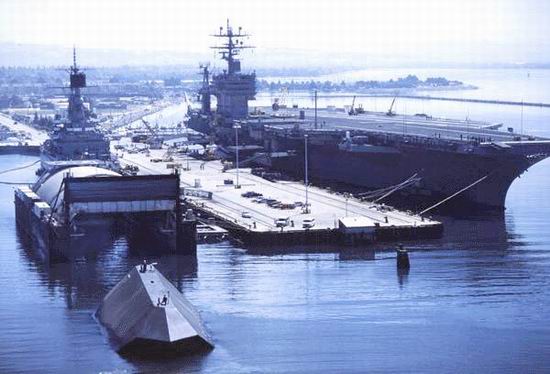
海影和休斯采矿驳船(HMB-1)
John Douglas Charlton, a retired Lockheed Corporation engineer, was arrested on 25 May 1995 for attempting to sell secret documents removed from the company at the time of his retirement. According to an Assistant US Attorney, the plans concerned the Sea Shadow, a Navy stealth project and the Captor Project related to mines which release anti-submarine torpedoes. According to the 10-point espionage indictment, Charlton tried to sell the information to an FBI agent posing as a foreign government representative.
John Douglas Charlton,一个退休的洛克希德公司工程师,在1995年5月25日尝试卖被他在退役时候从公司移走的秘密文件被拘捕。依照一位美国律师助理所称,是有关海影设计图,一个海军隐形计划和捕捉者计划有关系的去布雷释放鱼雷来反潜艇(anti-submarine)。依照多达10点间谍控告,John Douglas Charlton试着卖信息给一个FBI探员佯装成的一个外来政府代表。
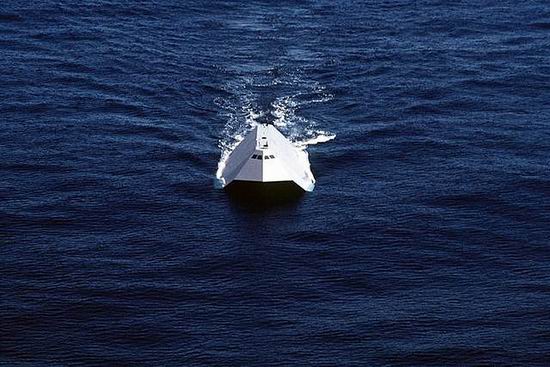
海影用来实验信号抑制技术
In anticipation of conducting future ship research and development testing, the U.S. Navy reactivated the Sea Shadow craft in early 1999. Engineers from Lockheed Martin Technical Services-San Diego managed repairs performed by the National Steel and Shipbuilding Company to make the craft seaworthy as well as to repair the vessel’s full-enclosure dry dock. Following reactivation, the crew sailed Sea Shadow from San Diego to the former Alameda Naval Air Station in Oakland, CA. Sea Shadow will support risk reduction for future surface ship platforms such as DD 21, the Navy's 21st Century Land Attack Destroyer. The platform will allow the Navy to explore and test, in a realistic at-sea environment, important DD 21 advanced information and automation technologies that support reduced manning and ship survivability. The US Navy Sea Shadow craft got underway at dusk on 18 March 1999, in San Francisco Bay to participate in events associated with Fleet Battle Experiment-Echo, sponsored by Commander, Third Fleet and the Maritime Battle Center. The Lockheed Martin Advanced Technology Laboratories will continue to manage Sea Shadow for the Naval Sea Systems Command Program office as well as continue its legacy as a source of advanced naval technologies.
在预测中会引导未来舰船未来研究与开发测试,美国海军恢复海影试验船活动在1999初期。工程师来自洛克希德·马丁(Lockheed Martin )技术服务公司- 圣地亚哥,国家钢铁和造船公司承担处理和修理工作,去使试验船适于航海,也修理船的全部外壳。海影开始恢复活动,全体船员启航海影从圣地亚哥到以前的奥克兰,加州的海军航空兵观测站。海影将支持风险减少用于未来水面舰船平台例如同样的DD 21,美国海军21世纪登陆攻击驱逐舰。平台将允许海军去探究和测试,在一个现实的在海洋环境,DD 21 重要的先进信息和自动化控制技术那支持减少人员配备和提高舰艇生存性。美国海军海影试验船在1999年3月18日在薄暮航行中,去参加联合事件用于舰队作战试验-Echo,被指挥官发起,第三舰队和海上作战中心共同参加。洛克希德·马丁(Lockheed Martin )先进技术实验室将会继续为海军的海洋系统指令计划办公室管理海影,也继续它的这个遗产被看做先进海军技术源点。
上一篇:没有了 下一篇:没有了
| IX 529 Sea Shadow
美国IX 529“海影”试验船 |
| Sea Shadow is a test craft developed under a combined program by the Advanced Research Projects Agency (ARPA), the Navy, and Lockheed Martin Missiles and Space Company.... [2016-01-25] |
